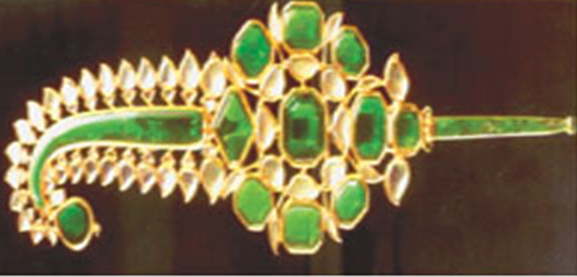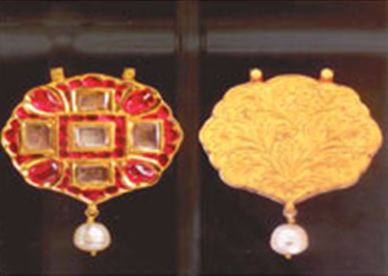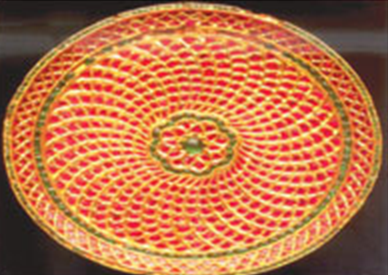Mughal jewellery at the Louvre
This is a collection of articles archived for the excellence of their content. Readers will be able to edit existing articles and post new articles directly |
Mughal jewellery at the Louvre
A jewelled tradition
By Batool Mahmood
The allure of magnificent gems in spectacular settings is hard to resist. So an exhibition of Mughal jewellery at the Louvre Museum in Paris this summer was a natural magnet for scores of visitors, including of course, many from the Indian subcontinent. The glittering pieces that were on display stirred up visions of a bygone age when the sub-continent’s indigenous gems were given an added sparkle, the result of attention lavished on them by the Mughal kings who flaunted them to such good effect. The jewels were used to add lustre to already sumptuous lifestyles and could not fail to impress visitors to the Mughal court.
One such visitor was Sir Thomas Roe, England’s first ambassador (1615 - 1619) to the court of the ‘Great Mughal’, Emperor Jehangir. In a letter addressed to Prince Charles, later King Charles I dated 30th Oct. 1616, he wrote: “In jewels (which is one of his felicities) he is the treasury of the world, buying all that comes, and heaping rich stones as if he would rather build than weave them.”
Gems and jewelled objects served a manifold purpose for the Mughals who, besides using them as personal adornments, gave them as gifts to reward and impress diplomatic emissaries, courtiers and other rulers. When the first Mughal ruler Babur (1526 — 1530) for example, entered Delhi in triumph after defeating the Lodhi ruler, he had immense booty at his disposal. This included jewelled daggers, swords and sword belts that he distributed as tokens of his esteem. The art of jewellery making was already flourishing at the time of the Mughal invasion but was given an added impetus by their personal interest, leading to the creation of works of art.
Indian artisans were essentially artists working with a palette of rubies, pearls, diamonds and emeralds that were strewn across a wide variety of canvases ranging from gold to rock crystal. It was a highly developed art form, nurtured by centuries of tradition and royal patronage. The Mughal Emperor Akbar for example, used the enormous wealth at his disposal to patronise the arts and we learn from records kept by his minister Abu-l Fazl Allami of the royal artistic establishments including their division into scores of departments. These were further subdivided into the various disciplines of the jewelled arts.
Following this organisational logic, the exhibition too was divided into thirteen sections depending on the techniques used to create the jewellery such as enamelling, hammered relief on precious metals and gold-embellished steel. One section consisted of large engraved stones such as emeralds, jade and rock crystal that were set into ornaments or fashioned into utilitarian objects such as drinking vessels and dagger hilts.
Some of the stones were too hard to be cut by steel tools so abrasive grits and powders were applied to the jeweller’s tools to enable the stones to be cut and polished. This was done in conjunction with oil and water, a combination that avoided a build-up of heat and allowed the slurry to be washed away at the same time.
An array of carved, sparkling emeralds arranged in one of the cases had weights ranging from 26 to 430 carats; the largest being made into a pendant with a pear-shaped diamond at its centre. This pendant was most likely made in the Deccan, probably between 1650-1675. Many of the pieces in the exhibition that would formerly have been considered Mughal, have been attributed to the Deccan. By the end of the 15th century there were five major kingdoms in the Deccan: Berar, Bidar, Bijapur, Ahmednagar and Golconda and Hyderabad.
The Deccan Sultans were renowned for their refined taste and culture and as patrons of the arts. Because of their geographic location they were also open to technological, artistic and cultural influences from Europe in the 16th century and incorporated these into traditional oeuvres in their courts. The influence of these new techniques and styles was far reaching and would be felt throughout India in the years to come.
And though Indian jewellery had a character and design that was totally home-grown, the assimilation of foreign techniques made for some interesting pieces and furthered the art of jewellery making. This trend must have been fostered by the emperors who were connoisseurs of jewelled objects. The Emperor Shahjehan, for example is known as a great builder and patron of the arts. He was reported by the Emperor Jehangir and by other sources such as European travellers to have been a practicing jeweller and an expert in gemstones. At times European jewellers were imported to the courts of the Great Mughals and their influence could be seen in the reigns of Jehangir and Shahjehan in the first part of the 17th century. Cameos for example, have a European provenance and a cameo pendant with a portrait of the Emperor Shahjehan that was on display is a testament to this influence.
The white and brown cameo is in agate and encircled with encrusted rubies. A painting of the Emperor Jehangir next to this piece shows him wearing a similar cameo pendant.
A number of photos of paintings from the memoirs of the Mughal emperors that are placed next to various display cases put the exhibits into context. We are transported to another time and place as we see the rulers richly clothed, sporting these fabulous jewels in their turbans; pearls strung around their necks; gems glittering in the jewelled hilts of their daggers and swords. In the display cases are jade and rock crystal hilts, dazzling scabbards, jewelled boxes, dishes, cups and containers; each an exquisite piece of art and a testament to the finesse and elegance worked into the fabulous riches of those times.
And even though towards the end of the Mughal dynasty there was a general decline in the patronage of the arts including the jewelled arts, this deeply ingrained Indian tradition continued to flourish and to produce exquisite jewellery well into the 18th and 19th centuries.
Hyderabad and Lucknow for example were centres of jewellery making and had styles that many would recognise as ‘Mughal’. A traditional choker necklace from Hyderabad known as a laccha (18th or 19th century) was on display. Encrusted with diamonds the size of pigeons eggs, emeralds and pearls, it vied for attention with two jewelled hair ornaments studded with rubies and emeralds that must have snaked down the length of a princess’ plait.
The collection now owned by another royal family, Sheikh Nasser and Sheikha Hussah al-Sabbah of Kuwait, travels the world and was started in mid-1970 by the Kuwait ruling family. It has been on loan to the Kuwait National Museum since 1983 and is a fitting testament to the glory of the Great Mughals.


